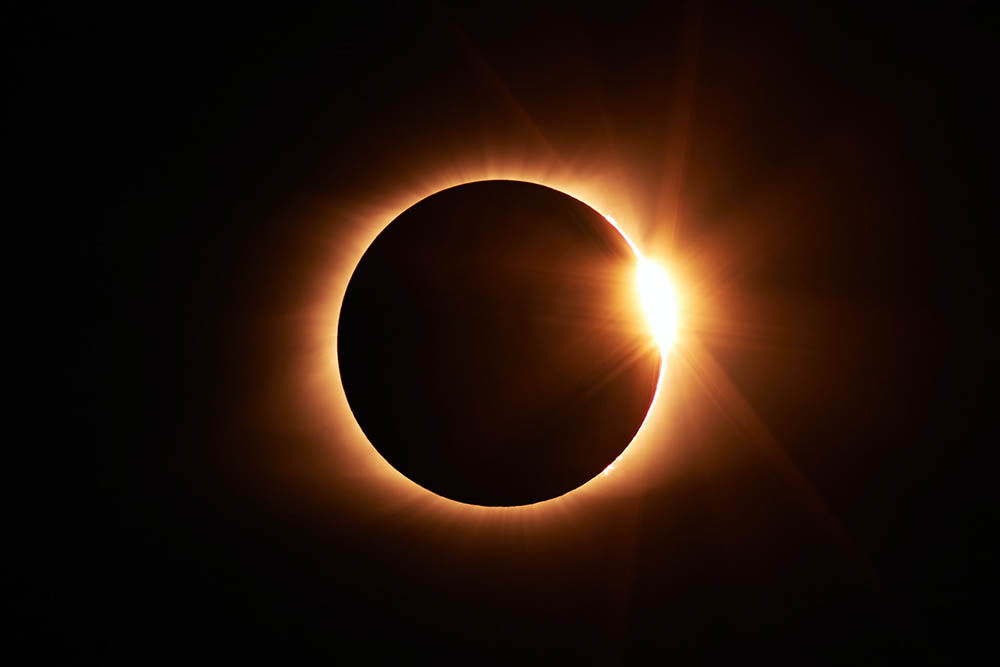What Is a Solar Eclipse? What Causes Lunar & Solar Eclipses?
Last Updated on

When we look at the sky, we like to think that we know what to expect, and for the most part, we do, but sometimes, something happens that is a little out of the ordinary.
A solar eclipse is one such occurrence. But what exactly is a solar eclipse, how often does one happen, and how can you spot one? Here, we dive into everything that you need to know. We also go over lunar eclipses, so hopefully, you won’t confuse the two in the future!

What Is a Solar Eclipse?
In short, a solar eclipse occurs when the moon passes between the Earth and the sun, blocking out a portion of the sun. This happens because the moon rotates around the Earth at the same time that it revolves around the sun, and sometimes those two paths intersect.
When this happens, the moon casts its shadow over a portion of the Earth, and this is a solar eclipse. While some of the most notable solar eclipse moments occur during total solar eclipses, it’s much easier to be in the path of a partial solar eclipse.

How Rare Are Solar Eclipses?
According to the London Natural History Museum, there are anywhere between two and five solar eclipses each year. However, those are partial solar eclipses. According to the same source, total solar eclipses occur once every 18 months on average.
So, while both partial and total solar eclipses do happen semi-frequently, they’re rare enough to take note of when they do happen.

When and Where Can You See a Solar Eclipse?
Due to the rotation of the Earth and the moon, solar eclipses don’t always occur in the same area. In fact, they’re constantly moving to different parts of the world.
It’s best to use a guide to help you track down where one is going to happen. As of this writing, the next solar eclipse will happen on April 20, 2023, and you’ll be able to see it in Australia and a few of the surrounding islands.
The next one in the United States will occur on April 8, 2024, and you’ll be able to see it throughout a large portion of the Central and Eastern United States.

What Is a Lunar Eclipse?
Solar and lunar eclipses are often confused for each other.
A solar eclipse happens when the moon passes between the Earth and the sun, and a lunar eclipse happens when the Earth is between the sun and the moon.
This means the Earth’s shadow blocks out the moon and changes the way that it looks to us on Earth. Lunar eclipses only occur during a full moon.

How Rare Are Lunar Eclipses?
While many people believe that lunar eclipses occur more frequently than solar eclipses, that’s not the case. According to Science Focus, a BBC affiliate, lunar eclipses happen two to five times a year and at roughly the same frequency as solar eclipses.
However, it’s much easier to spot a lunar eclipse. You just have to be at the right horizon to see it, while with a solar eclipse, you must be in a much more precise location.

When and Where Can You See a Lunar Eclipse?
Just like with solar eclipses, it’s best to use a guide when trying to track down when and where you can see a lunar eclipse. They only happen a few times a year, and you must be in certain regions to see them.
However, it is more likely that you won’t have to travel to see a lunar eclipse compared to a solar eclipse.

Final Thoughts
Solar eclipses are a rarity, but if you happen to be in the path of one, we highly recommend checking it out. Of course, you should always wear the proper protective gear, even if it’s only a partial solar eclipse.
Finally, if you’ve never experienced a total solar eclipse, we highly recommend doing whatever you can to get into the path of one. It might take a bit of planning, but it’s a unique experience!
Featured Image Credit: artbyrandy, Pixabay
About the Author Robert Sparks
Robert’s obsession with all things optical started early in life, when his optician father would bring home prototypes for Robert to play with. Nowadays, Robert is dedicated to helping others find the right optics for their needs. His hobbies include astronomy, astrophysics, and model building. Originally from Newark, NJ, he resides in Santa Fe, New Mexico, where the nighttime skies are filled with glittering stars.
Related Articles:
Binocular Magnification Chart: Numbers & Distances Compared
What Is the Best Binocular Magnification for Hunting? Optical Features Explained
When Were Binoculars Invented? History, Today & Future
How to Clean a Refractor Telescope: Step-by-Step Guide
How to Clean a Telescope Eyepiece: Step-by-Step Guide
How to Clean a Rifle Scope: 8 Expert Tips
Monocular vs Telescope: Differences Explained (With Pictures)
What Is a Monocular Used For? 8 Common Functions
